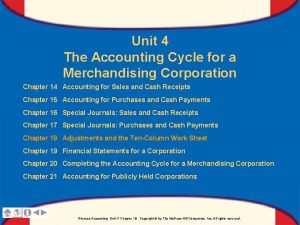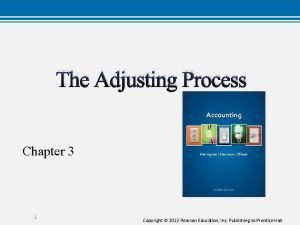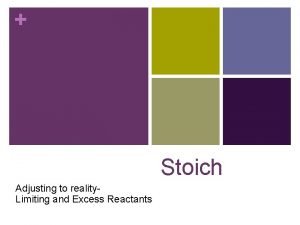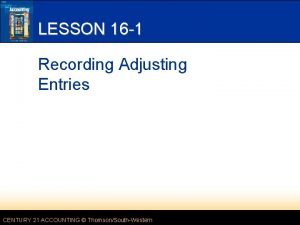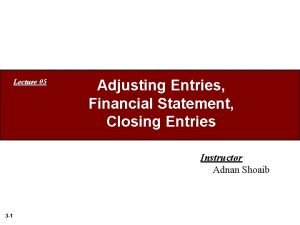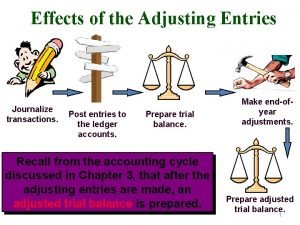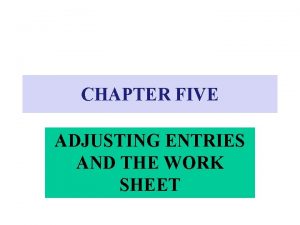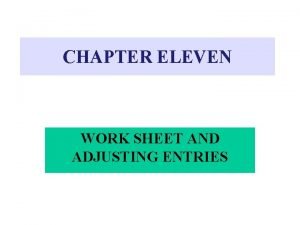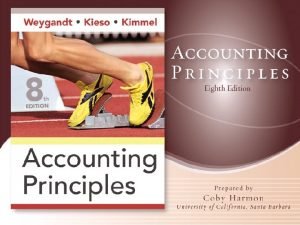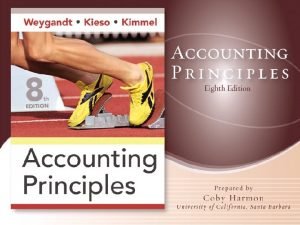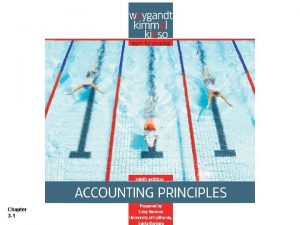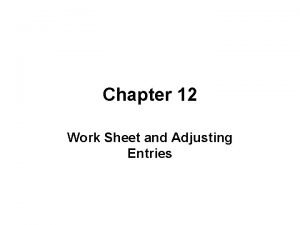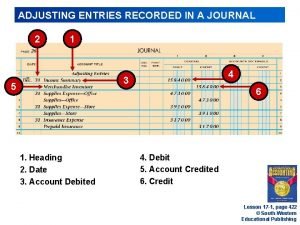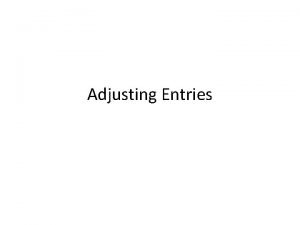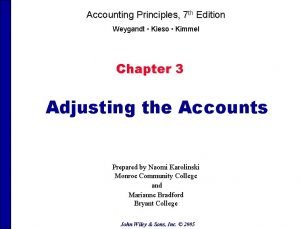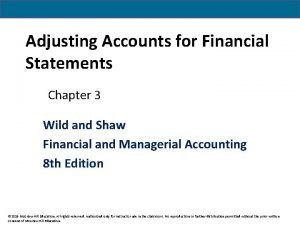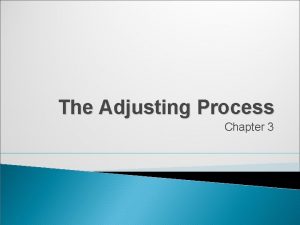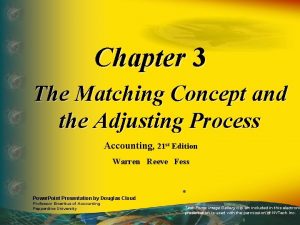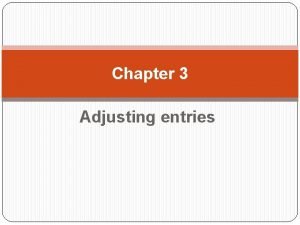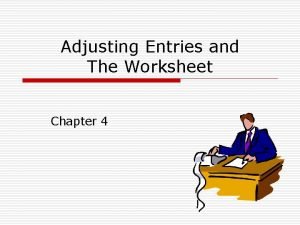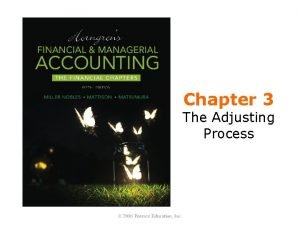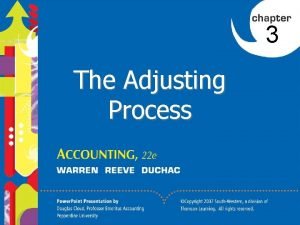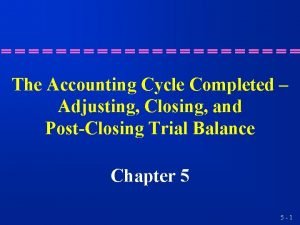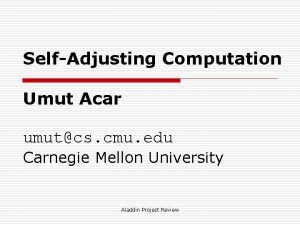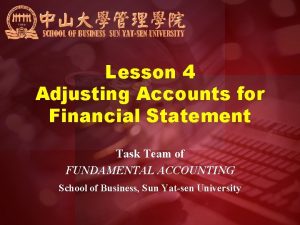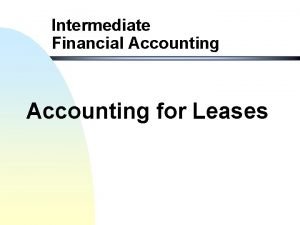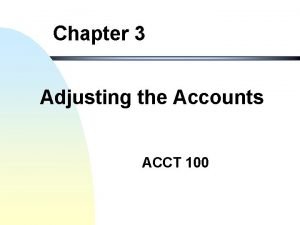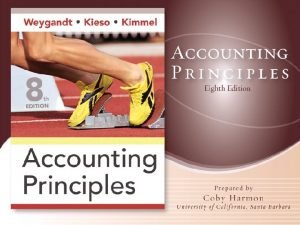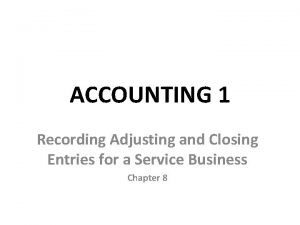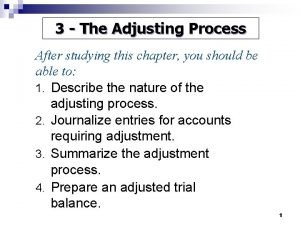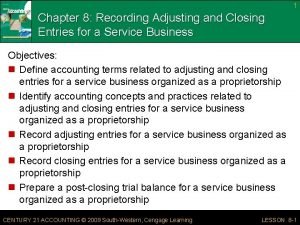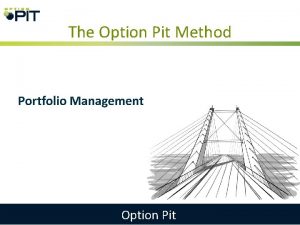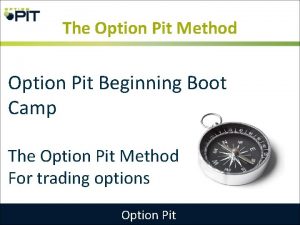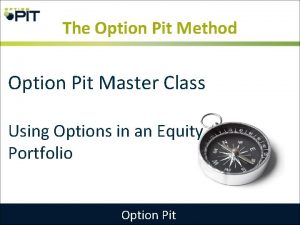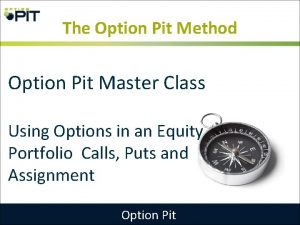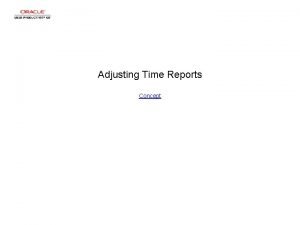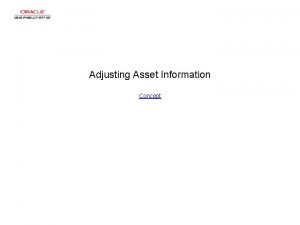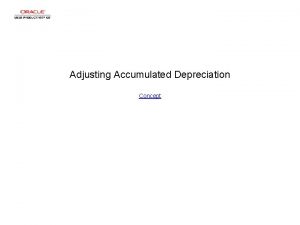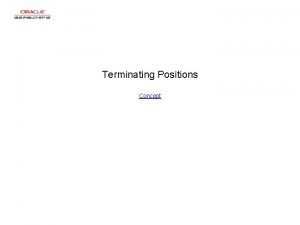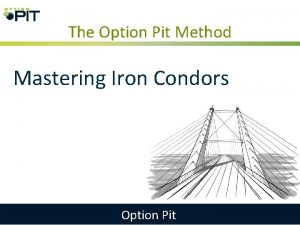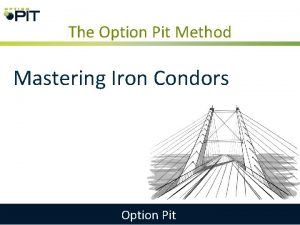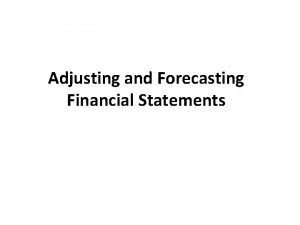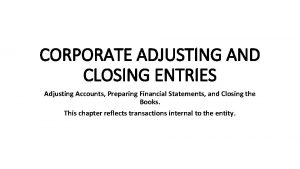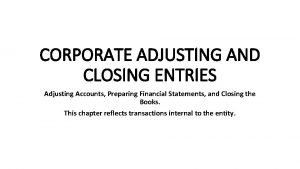Adjusting Positions The Option Pit Method Option Pit






























































- Slides: 62

Adjusting Positions The Option Pit Method Option Pit

What We Will Discuss • • What is an adjustment Why Adjust When to Adjust, when not to Basics of adjusting Adjusting Basic positions Adjusting Complex Positions Long gamma managment The Option Pit Method to adjusting

Adjustments • An adjustment to a position is an additional option trade added to an existing position • It is meant to reduce the ‘pain’ of a trade when a trade moves against a trade • An adjustment is a risk management tool that should reduce losses in a trade and/or extend a traders ability to stay in a trade • Adjustments should lead to more winner

Adjustment Reality • More often than not adjustments are losers • The average adjustment ends up costing a trader money • More often than not they are proven unnecessary • In many cases they fail to stop a trade from reaching max losses • In some cases the make the problem worse – Especially when they are done foolishly

Why Adjust • Fact: There are numerous studies out there that suggest that adjusting positions is a long term net loser to returns – Then why do we adjust trades? • Just because something reduces returns doesn’t mean it reduces risk adjusted return • If one can adjust properly they may cost themselves dollars but they might not cost themselves risk adjusted dollars

Risk Adjusted Returns • What is risk adjusted return? • Would you rather: – Make 20% on average with a max draw down of 30% – Make 15% with a max draw down of 15%? • The answer depends on duration and timing • Over the long haul series 1 might win but on a year to year basis series 2 might be better

2 Approaches Win/Lose Series 1 Series 2 Start o 100 Year 1 Win 120 115 Year 2 Win 144 132. 25 Year 3 Lose 100. 8 112. 4125 Year 4 Win 120. 96 129. 2744 Year 5 Win 145. 152 148. 6655 Year 6 Win 174. 1824 170. 9654 Year 7 Lose 121. 9277 145. 3206 Year 8 Win 146. 3132 167. 1186

Real World Example • A fund that launched in 2012 was up about 100% in its 1 st 3 years of trading – Seems like an all star approach • Dollars invested went from 100 to about 200 • In the crash of August 2015 the fund lost about 40% over a couple of days • The Return went from 200 back to 120 • Suddenly seems pretty pedestrian doesn’t it

Adjusting • Adjusting is done to ensure that the risk adjusted return of a trade is at its maximum level • Now the real problem… – MOST TRADERS SUCK at adjusting – They don’t engage in a process that reduces risk • They think saving a trade, not saving dollars • We are going to talk strategy THEN dig into specifics (be patient)

When to adjust • The 1 st key to understanding adjusting is understanding the trade itself • Some trades are great to adjust – Some are not • At onset of a trade one must have a plan – Trades should be set up with the intent of NOT adjusting – Trades should be set with contingecies to adjust

Trades with no adjustment • There are trades that should be set up with ‘no adjustment necessary’ • A max loss or price level is put into place for a trade – When it hits the loss level the trade is closed – When it hits the price point the trade is closed as well • Retail and professional managers HATE these trades…. but they make sense

Examples • Pair Trades • Wide Iron Condors • Weekly trades – Credit spreads – Butterflies • Naked options

Adjustable Trades • Credit Spread • Standard Flies • Iron Condors and High Probability Iron Condors • Broken wing and ratio flies • Straddles and Strangles

Adjusting • Adjusting begins with a plan • What are you going to do if: – The underlying rallies and IV is up – Underlying rallies and IV is down – Underlying falls and yada • But the most important thing to remember is the following

The Road To Traders Hell • The story of an incredibly wealth person in Las Vegas: You are not these people! • The road to trading hell paved with adding margin to a trade – In a world with a bottomless pit of money adding margin works in every other scenrio it leads to you never trading again • The retail trading story

Credit Spread • In adjusting a credit spread one needs to thin about intent • Are you a believer in the stock – Don’t adjust…take deliver and wheel – Let the bottom strike stop you out • If you are in it for income • Slowly buy put spreads as the underlying falls

Buttefly Adjusting

Adjustment 1

Adjustment 2

Eventually

1 by 3 by 2 • If a credit spread adjustment reaches beyond a 1 by 3 by 2 its time to stop • What you have now is a directional fly • If you are near max loss STOP • If not treat it like a fly and hope the underlying sits – Your trade is no longer a credit spread – Keep the SAME MAX LOSS

The Bad Trade

Part 2

Part 3

Margin • Notice the margin went from 1900 in potential losses to almost 7 k in potential losses • IWM goes on a tear – It tears you a new one • You can add all day it will kill you • Take a look at an IWM chart on the way DOWN

You are Screwed

So How Should I Adjust? • Adjusting is about reducing risk • Here is how market makers adjust – We buy and sell the underlying – We buy and sell options • When you are adjusting you are going to get SMART and trade like a market maker – Even if it reduces theta (OH NO NOT THAT!)

Butterfly • Adjust and then let it fall! – Reversion works if you buy yourself enough time • Think manage delta and let it come back – Or bail




How To Manage Flies • Buy calls and puts to cut delta in half as it moves • Have a Max loss • As it moves up or down keep buying options – As it revert back sell the options back • It will feel like spinning wheels • BUT on a trending market or a choppy market you will stay in the trade

Flies • Eventually the underlying will fall back from whence it came, if only a little bit • If you are not at max loss point yet the trade will be up money (most likely) • DON’T Get greedy take what you have been given and leave • P&L target NEVER changes the margin from calls and puts DOES NOT COUNT

Iron Condors • Iron condors are not flies in that they are looking for the underlying to truly stay in a range – A much winder range • Thus the goal is a little different – Rather than adjusting actively traders should look to adjust once twice at most – And only adjust if one has to

Iron Condor

Types of adjustments • Long call, long put • Ratio spread • Kite Spread

Condors • Like the fly, the key is to avoid adding a bunch of margin • Closing and rolling and increasing size would work…eventually…if you don’t blow out – But you will blow out • If you want to buy calls or puts, do it once, if the condor falls back sell it • If it doesn’t close at max loss

Kite spread • Buy 1 call below the condor • Sell several call spreads to pay for it at the condor level • Creates a ratio fly in the direction the trade is moving – Should have delta that helps the trade doesn’t hurt it • In theory adds to margin, does not add to ‘risk margin in practical terms

The Trade

Kite • Notice you buy gamma and delta in kite spread • One key adjusting is that they should put on opposite greeks of what the current position has on • If a position is short gamma and short delta – Adjustment needs to be long gamma and long delta


The Effect

The Goal • Smooth out the trade, make the pain less not non existant • Iron condors are supposed to hurt…or work…or both • They are never easy no matter what they say – Lots of liars out there remember that

Downside • Put spread – Easy enough (we can walk through if you guys want later – The trade when skew is super steep • Ratio back spread is my preffered method if I have to do an IC (which I rarely do) – The trade for a flatter curve

Skew

Back Spread It relatively cheap too which too. Is short delta, long gamma, and LONG VEGA


Ratio Flies • Ratio flies and Broken wings can be treated much like butteflies • The key is when to adjust flies • A fly is adjusted as the underlying moves away from the center • A ratio is adjusted as the underlying moves TOWARD it

Types • A 1 by 3 by 2 or broken wing can be managed the same way • DO NOT TOUCH until the underlying falls BENEATH the long strike • Slowly buy back the short strike as it moves • Keep the delta under control, not flat

Trade • trade

1 By 3 by 2

Your Question • Isnt that what the adjusted credit spread looked like? • A: Yes it is • Q: so why am I not doing that trade instead of credit spreads • A: great question you probably should be

Adjustment 1

Adjustment 2

You Might Notice • We turn things into butterflies at option pit • Yes we do, because that is what market makers try to do • If you can get the underlying to move your way you will win on these trades • Flies are the best chance to win once the underlying picks a direction

Straddles and Strangles • The average retail trader should own a few long gamma trades like straddles • Andrew will teach you what a couple of straddles can do for a portfolio • Im here to teach you how to adjust them

Straddle

Adjustments • When the delta exceeds the gamma by more than 2 on a standard stock, cut the delta in half • Do so by sell or buying stock • Do so by selling options one is long against the straddle • An underlying falls sell puts • An underlying rallies sell calls



Summary Understand why we adjust Understand when not to Take a stand Adjust in ways that reduce risk do not add to risk • Be smart in what you do • Plan ahead • •

Special Offer The Option Pit Gold Course This was just the beginning: understand how to trade like a professional learn from the masters Ø Access to our special Gold Members Training Ø Review ALL past Saturday Class, plus the next 4 free Ø For months of Option Pit Live Ø Email and phone support Normally 1950. 00 Dollars yours for Just 1097. 00 Dollars Use code GOLDCAMP Email: info@optionpit. com Phone: (888) TRADE-01 (888 -872 -3301) www. optionpit. com/memberships/gold
 Optionpit
Optionpit Konvergensi option adalah
Konvergensi option adalah Option a option b
Option a option b White vincent method formula
White vincent method formula Method of adjusting isotonicity
Method of adjusting isotonicity Prismoidal correction
Prismoidal correction Conclusion of symposium
Conclusion of symposium Chapter 18 adjustments and the ten-column worksheet answers
Chapter 18 adjustments and the ten-column worksheet answers Journalize adjusting entries
Journalize adjusting entries Example of limiting reactant
Example of limiting reactant Accrued expenses entry
Accrued expenses entry Adjusting entries accounting
Adjusting entries accounting Adjusting entry accrued expense
Adjusting entry accrued expense Journalizing adjusting entries
Journalizing adjusting entries Accrued wages
Accrued wages Journalizing adjusting entries
Journalizing adjusting entries When using a worksheet adjusting entries are journalized
When using a worksheet adjusting entries are journalized Adjusting entries
Adjusting entries How to adjust merchandise inventory on a worksheet
How to adjust merchandise inventory on a worksheet Accrued revenue adjusting entry
Accrued revenue adjusting entry The time period assumption states that
The time period assumption states that Accrued revenue adjusting entry
Accrued revenue adjusting entry Adjusting entries merchandise inventory
Adjusting entries merchandise inventory Balancing an equation involves adjusting
Balancing an equation involves adjusting Balancing an equation involves adjusting
Balancing an equation involves adjusting Balancing equations
Balancing equations Supplies inventory adjusting entry
Supplies inventory adjusting entry Precollected income
Precollected income Adjusting accounts for financial statements chapter 3
Adjusting accounts for financial statements chapter 3 Unearned revenue journal entry
Unearned revenue journal entry What's the scp for adjusting a pi ilium?
What's the scp for adjusting a pi ilium? Adjusting accounts for financial statements
Adjusting accounts for financial statements Which types of adjusting entries are natural opposites?
Which types of adjusting entries are natural opposites? Adjusting entries example
Adjusting entries example Adjusting a recipe
Adjusting a recipe Adjusment entries
Adjusment entries Abbreviations and measuring techniques worksheet answers
Abbreviations and measuring techniques worksheet answers Adjusting the accounts chapter 3 solutions
Adjusting the accounts chapter 3 solutions Adjusting entries cash
Adjusting entries cash 12 column worksheet accounting example
12 column worksheet accounting example Valve adjusting wrench berfungsi
Valve adjusting wrench berfungsi Adjusted trial balance example
Adjusted trial balance example The updating of accounts is called the adjusting process.
The updating of accounts is called the adjusting process. Journalizing and posting adjusting and closing entries
Journalizing and posting adjusting and closing entries Umut acar
Umut acar Why is evaluating and adjusting a spending plan important
Why is evaluating and adjusting a spending plan important Adjusting the accounts
Adjusting the accounts Accrued interest journal entry
Accrued interest journal entry Jelaskan fungsi fuel system
Jelaskan fungsi fuel system Adjusting the accounts chapter 3
Adjusting the accounts chapter 3 Adjusting the accounts chapter 3
Adjusting the accounts chapter 3 Four closing journal entries
Four closing journal entries Chapter 3 the adjusting process
Chapter 3 the adjusting process Application problem 8-1
Application problem 8-1 Hình ảnh bộ gõ cơ thể búng tay
Hình ảnh bộ gõ cơ thể búng tay Slidetodoc
Slidetodoc Bổ thể
Bổ thể Tỉ lệ cơ thể trẻ em
Tỉ lệ cơ thể trẻ em Gấu đi như thế nào
Gấu đi như thế nào Chụp phim tư thế worms-breton
Chụp phim tư thế worms-breton Hát lên người ơi
Hát lên người ơi Môn thể thao bắt đầu bằng từ chạy
Môn thể thao bắt đầu bằng từ chạy Thế nào là hệ số cao nhất
Thế nào là hệ số cao nhất







